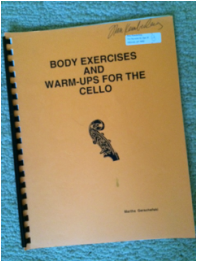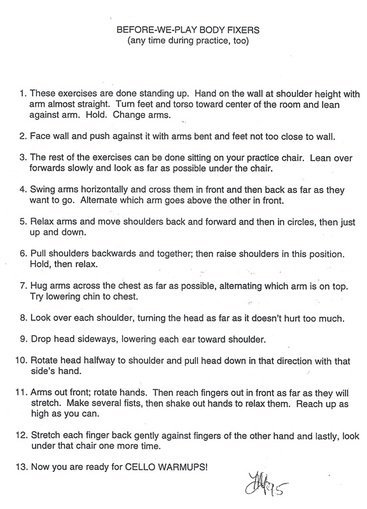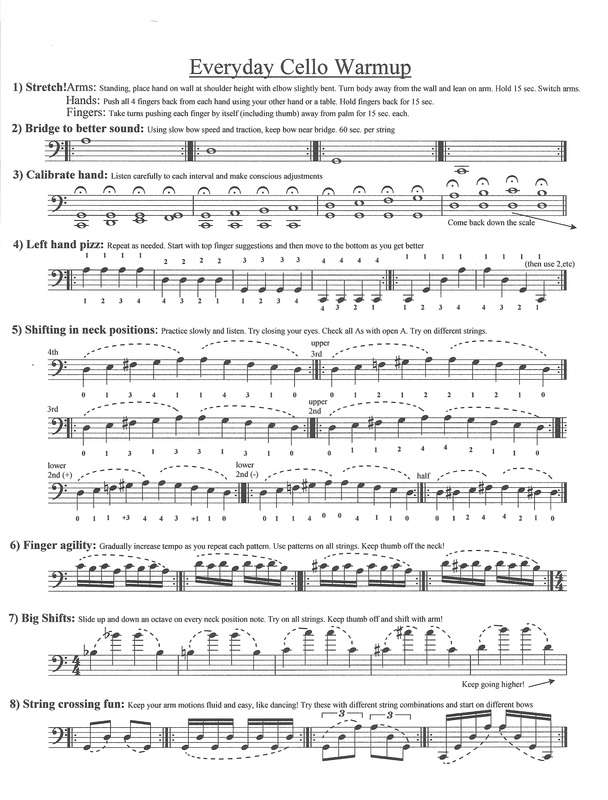One of my students was disappointed in a recent performance that she had given cold turkey.
"No way," I found myself shaking my head. " You must always warm up first. You can't expect your hands to be able to go from zero to concerto like that!"
 Martha's warm up book
Martha's warm up book When I was a young person, Martha constantly reminded me that I needed to warm up. She even wrote an entire book about it (which I highly recommend!). But, as with many wisdoms she shared with me back in the day, I had to learn it on my own (I have some kind of problem with doing what people tell me to do sometimes. Even if they are exactly right! See my previous blog post: Saying Nay to the Naysayers and you'll get a better idea of what I am talking about).
So on my best warm up days, I would hastily wade through a D major left hand pizzicato scale (see below).
And that's it.
If only I had made sure that warming up was a part of my practice and performance routine. Like Brian Magnus who says,
"A daily warm-up routine is important at the start of a practice session. Jumping right in to difficult music can cause tension, and frustration when your hands don't seem to be working right."
(See Brian's excellent post on practicing, which includes a section on warm ups.)
It has become even more clear as I have gotten older. Nowadays, I know I can't play well until I have a little slow and easy time with my cello. I have finally learned!
But it didn't really hit me that I needed to teach my students how to warm up until very recently. I have been watching my older students suffer. Arthritis and bursitis wreak havoc on their joints and I desperately want to help ease the pain.
Stretching
| Emily Wright herself has a post entitled "Yoga for your hands" which is a detailed description with pictures of stretches you can do that are specifically designed for cellists. A massage therapist and cellist named Linda Hickey wrote an excellent article on the hows and whys of stretching before playing. Martha devoted an entire page of her warm up book to stretching (see right). Violin teacher, Ronald Mutchnik, created his own list of stretches for all string players. (If violinists need to stretch, well... we better do more!). As you will read in the above links, stretching is good for your body. But it also just feels good! |
Don't forget the bow
I love to begin each day with slow bows on my open strings at the bridge. It wakes up your bow hand gradually and doesn't ask too much of it at the start. It can also help your cello sound better!
When I first experimented with warming up (in college, of course), I would be in the practice room at 7 am droning on my open strings. This was in the era before my tour of Brazil when I was introduced to coffee for the first time, so there I was trying to warm up at the crack of dawn without any kind of caffeine to help.
Needless to say, a few times I jolted awake to find I had fallen asleep playing my open strings!
Check out this really fun bow warm up page : http://www.stringedtech.com/2013/02/02/bow-warm-up-exercises/
With these invigorating bow games, I guarantee you won't fall asleep during your warm up!
Preventing injury
Cellist Emily Wright knows a thing or two about the injuries one can incur by playing cello. A recent blog post of hers about her injuries that prevent her from playing was so moving and sad. In this post there was a basic plea to all of us:
"So if your teacher tells you your hand is too tense, that the way you’re using your body will cause injury, is only a short term fix, or is unsustainable: please take it seriously, while you still have the option to play without pain. I would give anything to go back and do it all differently if I could."
I am passionate about ergonomic technique as well, but the most important thing we can do to prevent injury is develop a warm up routine and stick to it.
The bottom line
But you don't want to spend all of your valuable practice time just waking up your muscles and joints!
So, to fill the need for a short but effective recipe for warm ups, I have devised an exercise sheet that will take only about 10 minutes of your time. The best part is that any cellist at any age and any level can use it!
Feel free to modify it to fit your needs!
Learn from a pro
http://musaic.nws.edu/videos/warm-up-routine-on-the-cello
And leave a comment to let me know how you like to warm up!




 RSS Feed
RSS Feed